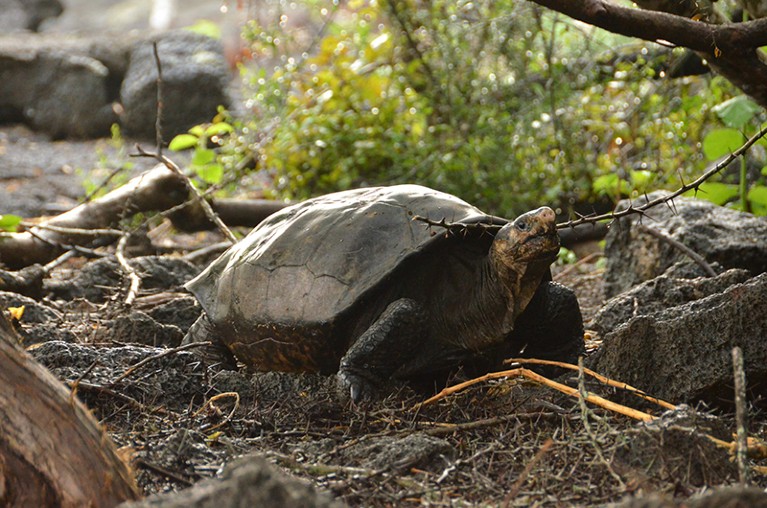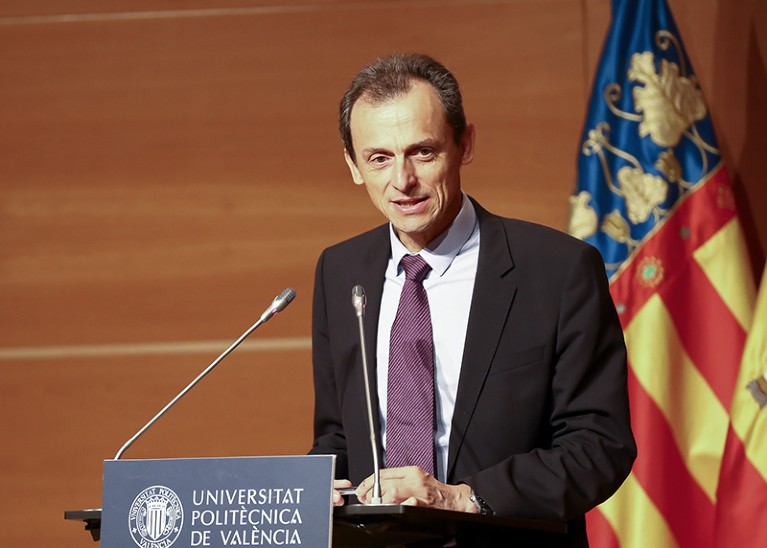EVENTS
‘Extinct’ giant tortoise spotted alive A conservation expedition in the Galapagos Islands has found a living member of a giant tortoise species thought to have been extinct for more than a century. The team spotted the female Chelonoidis phantasticus on Fernandina Island, Ecuador’s environment ministry announced on 20 February. Researchers captured the animal and brought it to a tortoise breeding centre on Santa Cruz Island. They are running genetic tests on the tortoise to confirm definitively that it is a C. phantasticus. Expedition members found tortoise tracks and faeces elsewhere on Fernandina, suggesting that other C. phantasticus might exist on the island. The last time anyone saw this species alive was in 1906.

Specimen of a giant tortoise that was believed to be extinct, has been spotted at the Fernandina Island, in Galapagos, Ecuador.Credit: Ecuador Environment Ministry/EPA-EFE/Shutterstock
MEDICAL RESEARCH
Stem-cell therapy Scientists in Japan now have permission to inject ‘reprogrammed’ stem cells into people with spinal-cord injuries. An upcoming trial will mark the first time that induced pluripotent stem (iPS) cells have been used to treat the spinal cord, after a committee at Japan’s health ministry approved the study on 18 February. IPS cells are created by inducing cells from body tissue to revert to an embryonic-like state, from which they can develop into other cell types. Hideyuki Okano, a stem-cell scientist at Keio University in Tokyo, will coax donor iPS cells into becoming neural precursor cells, which can develop into neurons and glial cells. Okano’s team will inject the neural precursor cells into four people about two to four weeks after injury, then monitor them to be sure that the therapy is safe and effective before deciding whether to start a larger clinical trial. The first person is expected to be treated in the second half of this year. Okano has demonstrated that the procedure can regenerate neurons in monkeys with injured spinal cords, and increase their mobility.
SPACE
Asteroid landing Japan’s Hayabusa2 spacecraft landed successfully on the surface of the asteroid Ryugu on 22 February. As the probe gently touched down, it fired a projectile into the surface to kick up sand, pebbles and fragments of rock into a collection chamber called a sampler horn. Yuichi Tsuda, the mission’s project manager, later confirmed at a press conference that the projectile-firing sequence had happened as planned, but the team awaits confirmation that there is material in the sampler horn. If successful, it will be only the second time in history that a probe has collected a sample from an asteroid, after a previous mission, Hayabusa, did so in 2005. The probe has now returned to its ‘parking’ altitude, about 20 kilometres above the asteroid’s surface.
Space power China wants to be the first country to launch into space power stations that capture the Sun’s energy and beam it back down to Earth, Chinese state media reported on 14 February. The idea of space-based solar power stations has been around for decades, but the cost of launching stations that could weigh up to 1,000 tonnes is a major obstacle. China is considering using 3D printing to construct stations in space, to avoid launching the hefty weight. The stations would use photovoltaic cells to capture solar energy that is then transferred to antennas that transmit microwaves or radar to Earth. Receiving stations would then convert the microwaves into electricity, which could be used to power electric cars, according to state media. The advantage of space-based stations is that they could catch the Sun’s energy before it dissipates in the atmosphere. They would also be a more stable energy source than ground-based stations, because they could avoid fluctuations due to weather, seasons or night.
Space force The White House has formally proposed establishing a Space Force to coordinate US military efforts in space. The idea has divided many in Congress, which would need to approve the proposal for it to become reality. Administration officials had earlier discussed establishing the Space Force as a sixth branch of the military, which prompted critics to argue that the Pentagon did not need more bureaucracy. The directive that President Donald Trump signed on 19 February nests the Space Force less controversially within the Air Force. Civilian agencies that deal with space, such as NASA and the US National Oceanic and Atmospheric Administration, would not be involved in the Space Force. The proposal is the fourth space-policy directive that Trump has signed during his presidency.
POLICY
Spanish reforms Spanish science minister Pedro Duque (pictured) has announced reforms to cut red tape and make life easier for researchers. The Spanish government issued the reforms as a temporary measure on 8 February, and parliament is expected to review and approve them as permanent law by 28 February. The changes make it easier for public research institutions to hire staff on a permanent contract, and for scientists to buy equipment and to return to a science career after taking maternity or paternity leave. They have been widely welcomed by the country’s scientists, but many say that further reforms are needed to improve the research system, which has been affected by years of funding cuts.

Spain’s science minister, Pedro Duque, has announced widely-welcomed research reforms.Credit: Jose Miguel Fernandez/NurPhoto via Getty
Climate panel US President Donald Trump is planning to establish a working group of federal scientists to re-evaluate the government’s analyses of climate science, according to media reports. The analyses include the national climate assessments, reports that are mandated by law and which examine how climate change will affect different areas of the country and sectors of the economy. The latest assessment, released in November 2018, stated that US communities are increasingly vulnerable to the dangers of a warming world, including larger wildfires. The findings contradict positions taken by Trump and administration officials, who have questioned well-established tenets of climate science. Some researchers fear that the formation of the climate-science group could be used to undermine the scientific consensus on global warming.
POLITICS
Moldova elections A Moldovan mathematician was among several academics running in the country’s general election on 24 February, hoping to improve research and education. The academic candidates hope to depoliticize science, improve education and address high levels of brain drain in the nation of 3.5 million people, which sits between Romania and Ukraine and has its political allegiances split between European Union and Russia. The candidates say that a combination of corruption — Moldova ranks 117th out of 180 countries in Transparency International’s Corruption Perceptions Index — poverty and a lack of funding makes life difficult for Moldovan academics, who struggle to travel to international conferences or win national research grants on the basis of merit. The researchers’ campaigns have energized some in the scientific community — although people fear that the academics, if elected, might still be too few in number to drive the much needed changes to Moldovan science.
RESEARCH
CRISPR ethics A journal has retracted an article on the ethics of human gene editing by researcher He Jiankui, who claimed last year that he had helped to make the world’s first genetically altered babies. He announced on 26 November 2018 that he had edited the genes of embryos that resulted in the birth of twin girls, outraging scientists around the world. The same day, The CRISPR Journal published a perspective article online authored by He and others. It offered draft ethical guidelines for using gene editing with reproductive techniques. But the journal retracted the article on 21 February. In a statement, it said that He had not disclosed that he was conducting clinical studies that involved the germline editing of human embryos. Because this was directly relevant to the opinions in the article, the failure to disclose this conflict of interest affected the “editorial consideration of the manuscript”, the journal said.
TREND WATCH
Scientists who work in the pharmaceutical industry have begun to publish a higher proportion of their papers open access than have academics who are not affiliated with the industry. This is according to an analysis uploaded to the preprint server SocArXiv on 7 February. Alfredo Yegros-Yegros and Thed van Leeuwen, information scientists at Leiden University in the Netherlands, trawled through papers listed on the Web of Science database that were published between 2009 and 2016 and picked out those that included at least 1 author from 1 of 23 large pharmaceutical companies. The researchers then identified whether or not these studies were open access. They compared the number of open-access papers with that of all publications in medicine-related fields. The researchers found that in 2009, the proportion of open-access papers published by drug companies was just over 20% — lower than the 29% found in the general medical literature. But over the next 7 years, the percentage of industry open-access papers steadily increased to more than 40% in 2016, the first year in which it exceeded the proportion of open-access articles in the general literature.

Source: A. Yegros-Yegros & T. van Leeuwen https://doi.org/c23j (2019).





